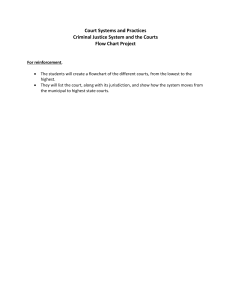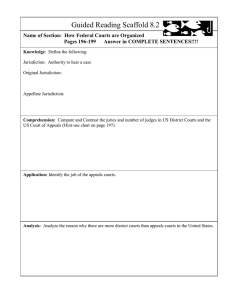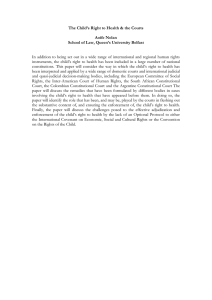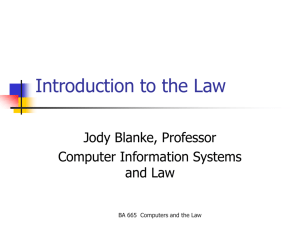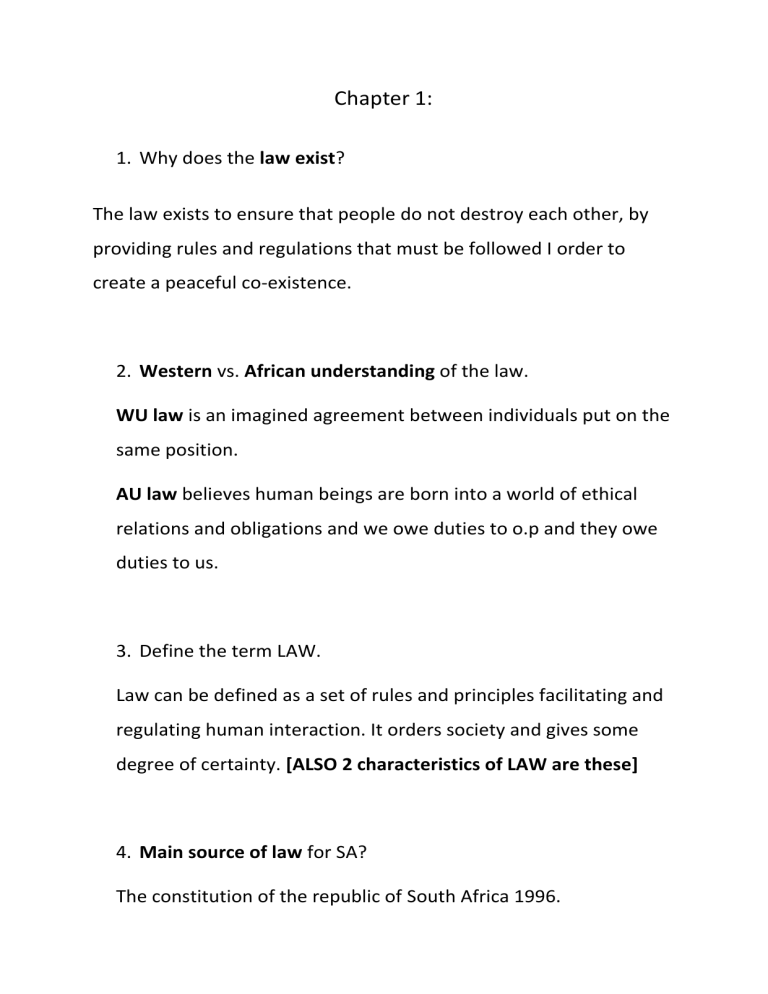
Chapter 1: 1. Why does the law exist? The law exists to ensure that people do not destroy each other, by providing rules and regulations that must be followed I order to create a peaceful co-existence. 2. Western vs. African understanding of the law. WU law is an imagined agreement between individuals put on the same position. AU law believes human beings are born into a world of ethical relations and obligations and we owe duties to o.p and they owe duties to us. 3. Define the term LAW. Law can be defined as a set of rules and principles facilitating and regulating human interaction. It orders society and gives some degree of certainty. [ALSO 2 characteristics of LAW are these] 4. Main source of law for SA? The constitution of the republic of South Africa 1996. 5. What is the constitution? It is a document that is written and given force of law by the democratically elected constitutional assembly that tells us what the states powers are and contains the bill of human rights. 6. Other sources of Law and there definition? Legislation: laws written by democratically elected bodies African customary law: laws of the nation’s first people Common law: laws inherited from colonial heritage [mix of roman-Dutch and English law] Custom: practices that developed into law because of usage over a period of time. International law: laws drafted by agreement between diff countries. Foreign law: laws of a different country, specific to that country. 7. Diff between LEGAL NORM and MORAL NORM. LN involves the whole community. MN involves a select group of people. 8. 2 types of justice and their definitions. Distributive justice: Ensures equal distribution among equals. Corrective justice: Aims to restore inequalities. 9. LEGAL POSITIVISM VS. NATRUAL LAW APPROACH. LPA: This approach believes that law is that which is and not that which should be. It is irrelevant whether the law is just and fair. Whatever is written in the sources of law are believed to be what should be followed. NLA: This approach believes that law has a moral dimension. It believes that the norms are found in the harmony and order of nature or in human nature. The eternal laws of god are seen as a source of natural law. 10. Define legal certainty. Legal certainty means that law is predictable, that it will be applied consistently and that it has a fixed and certain content. 11. Factors affecting LC. Language: words don’t have fixed simple meanings. Changing Values: laws adapt to remain effective. Judicial discretion: the way the law is interpreted. Chapter 2: 1. Define the term uncodified. A legal system is not written down in a single code. 2. Importance of LEGAL HISTORY? It explains why the law is how it is today, as it explains the process that the law went through to get to what it is today. 3. Is SA law STATIC or LIVING? SA law is living which means that the LAW can adapt to society’s new developments. 4. How many Phases did SA go through and what are they? SA law went through 5 phases. 1. African Phase: customary law 2. Dutch colonization: Roman-Dutch Law 3. English colonization: mix of RD law and English law 4. Apartheid law: NP came into power and made Aprthd.Laws 5. Transformative Constitutional Democracy: 5. Modernism vs. Purism. 6. Positivist vs. non-positivists. Chapter 3: Sources of Law: 1. Primary sources vs. Secondary sources of Law P: The actual law in the form of constitutions, courts cases, statutes and administrative rules and regulations. S: Restating of the law while also discussing, analyzing, describing, explaining or critiquing it as well. 2. The constitution as a P source of law. It’s binding and authoritative Holds sovereignty Current C is 1996, interim C is 1993 Has a bill of rights. [Chapter 2 of C.] Judges can’t disagree with C or provide personal opinions. Divides gov. into 3 branches. o Executive [enforces law] Consists of Presd. And Cab. Cab. Has minister’s w/2 deputies. [*political heads*] Ministers have pwr over G.D’s and their deps.[*administritave heads*] o Legislative [Creates Law] Consists of Parliament 2 house of Parl. NA and NCoP 9 Provincial Parliaments 267 Municipalities in SA o Judiciary [Applies, interprets and develops the law] Consists of ALL courts From highest to lowest: Constitutional courts [1] Supreme Court of Appeal [1] High Courts [9] District Magistrate Courts and Regional Magistrate Courts. [a lot] This is put in place to ensure no branch has complete sovereignty. 3. Legislation as a PSoL: DEF: *Law laid down by a branch of state. Known as Statutes, Acts of Parliament or Legislation. PSoL + binding authority Quickest, most effective way to amend old laws. Legislation is passed when: o Gaps in the law. o Law no longer corresponds to modern society. o Defect/loopholes in the law. 4. **How legislation is made: New plea of Legislation arises. The Government drafts Green Paper that puts various policy options forward about a particular topic. The Green Paper goes through the public eye for opinion [Public Participation Process] The Government then drafts White Paper which states government policy. The White Paper then goes through the Public Participation Process. Then experts would drafts a Bill concerning this matter. Usually the Bill is published in the Government Gazette to allow the public to comment on the Bill. The Minister responsible for this matter then introduces the Bill at the National Assembly for the First-reading. Each member has a copy of the Bill and after its introduction the Bill is referred to a Portfolio Committee. The members then investigate the Bill, the public commentary and recommend changes and make new proposals. The changes are recorded in a report and is then presented at the next National Assembly for the Second-Reading. During this reading the purpose and principles of the Bill is debated. At the end of the debates proposals [Amendments] may be made regarding the Bill and these amendments are CONSIDERED by the Portfolio Committee, after which it again drafts a report. The National Assembly then takes the report into CONSIDERATION and VOTES based on the Second-Reading. Once the Bill is approved by the Nation Assembly it is referred to the National Council of Provinces for approval, where the SAME process as in the National Assembly is followed. If the National Council of Provinces DISAPPROVES the Bill, the CONSTITUTION states how the disapproval should be resolved. If the National Council of Provinces APPROVES the Bill, it is referred to the President for assent. 5. When does Legislation stop being in force: Repeal: Parliament decides to end an Act/Legislation/Statute Sunset Clause: when the act has a clause stating that it will stop being in effect on a particular date. Judicial Review: when courts review an Act/Legislation/Statute and find it to be unconstitutional. 6. Interpreting statutes: 2 Approaches: o Theoretical Approaches: Literal Approach: Follow law as it stands Purposive Approach: Look for reason as to why law was instated Transformative Approach: Apply the Constitution o Practical Approaches: Grammatical Approach: Interpret the words as they are defined in the ordinary dictionary. Systematic Approach: Legislation should be read as a whole Teleological Approach: Look into the deeper meaning as to why the statute exists Historical Approach: Look at previous versions of the ACT Comparative Approach: Compare it with law of other countries 6. Legal Precedents as a PSoL: Origins from English law Reason for use: o The law applied to specific situations should be applied to similar cases o Stare decisis [to stand by previous decisions]. 7. Ratio Decidendi and Obiter dicta: Ratio decidendi refers to statement of law that arises from the reason for the court’s decision. Obiter dicta refer to statements that are not necessary for a court’s findings. 8. More than one judgement w/regards to precedent: Majority judgment: results in precedent Minority judgement: no precedent but will have persuasive power in future. Separate Concurring judgement: No precedent, no disagreement but judge still hands different judgement. 9. Pros and Cons of Precedent: Pros: Legal certainty and legal uniformity Cons: Incorrect decisions and Legal reform is difficult [takes a while for law to adapt] 10. Common Law as a PSoL: The law of a country which is not contained in legislation. Refers to 17th and 18th RD Law and English Law. Roman law was codified in the Corpus Iuris Civilis. 11. Custom as a PSoL: Generally unwritten law. Requirements for custom to be recognized: o The custom must have existed for a long time o It must be observed generally by the community in which it applies o It must be reasonable o Its content and meaning must be certain and clear Chapter 4: 1. Substantive vs Procedural Law: S: part of the law which determines the content and meaning of the different legal rules and principles. P: part of the law which regulates the enforcement of substantive law. 2. Branches of Procedural Law: Law of Criminal Procedure Concerned with the way in which someone who is suspected of having committed a crime is prosecuted and tried. Law of Civil Procedure Methods by which private law disputes are brought before the court. Law of Evidence Concerned with how evidence must be presented before the court. 3. Branches of Substantive Law: Private law Public law Chapter 5 and 6: First-generation Rights Definition Provide a shield for the individual to protect himself against state authority and guarantee freedom from unlawful interference by the state. Second-generation Rights Definition They do not require the state to refrain from doing something specific, but to take positive action as they are a sword against the state. Third-generation Rights Definition: These pertain to groups and have been identified more recently. Chapter 13: 1. Jurisdiction A court’s jurisdiction is determined by three factors: The geographical area Type of case Whether the case is appearing before a court for the first time or not. 2. District Courts Criminal cases: The criminal jurisdiction of a District Court is restricted. Civil cases: The civil jurisdiction of a District Court is also restricted, in the sense that it has no jurisdiction in matters which fall within the exclusive jurisdiction of the High Court (Constitutional matters: A District Court has jurisdiction with respect to constitutional matters only if an Act of Parliament provides it with such jurisdiction. 3. Regional Courts Criminal cases: A Regional Court can try any criminal offence (even those that a District Court cannot hear such as murder and rape) but not treason. Civil cases: The civil jurisdiction of the Regional Courts is slightly more expansive than that of the District Courts. Constitutional matters: The same principles apply to Regional Courts as explained above for the District Courts. 4. High Court Jurisdiction as court of first instance: When the High Court sits as court of first instance, usually only one judge presides. Appeal and review jurisdiction: The High Court can review and hear appeals of criminal and civil cases that were first heard in the Magistrates’ Courts. 5. Jurisdiction of the Supreme Court of Appeal The Supreme Court of Appeal is a Superior Court in terms of the Superior Courts Act. 6. Jurisdiction of the Constitutional Court The Constitutional Court is a Superior Court in terms of the Superior Courts Act. According to section 167 of the Constitution, read with the Superior Courts Act, the head of the Constitutional Court is the Chief Justice. The Chief Justice is also the head of the South African judiciary as a whole. Other members of the court are the Deputy Chief Justice and nine other judges. In any case, at least eight judges must hear the matter.
